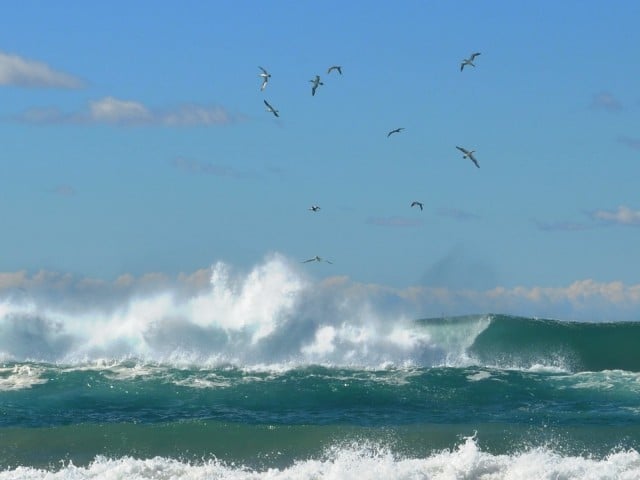
The group of gannets circle over the back breakers and plunge into the water between the last waves. The dolphins are also in the chase, herding the unseen prey along the beach toward the Cape Byron lighthouse. The wind sweeps up the waves, fanning the crest into a thin spray, blowing ashore, tasting to me like wild kisses. Who will tell where they come from and where will they go?
It’s open knowledge that Australasian Gannets (Morus serrator) wander the seas some 13,000 kilometres between here on the north coast, down to Bass Strait and away to Norfolk Island and New Zealand.
Their wingspan is nearly two metres. Their dive speed reaches 100 kilometres per hour as they drop from 30 metres above water to 10 metres below. Air sacs in the face and chest cushion the impact. Underwater, their eyes instantly adjust as they wing towards the fish or squid. As successful hunters, living 30-40 years, bonding in pairs to raise chicks in colonies perched near good food sources, they ought to be signs to observers about marine conditions.
What’s not quite clear is what gannets indicate. They don’t offer morality lessons: they form pair bonds that last for years but will adopt new partners if previous ones don’t return in time for the breeding season. The old stereotype of gannets as thieving greedy guts is mistaken: each colony has its own well defined fishing areas, respected by the birds of each group.
Sometimes they signal trouble in ‘real time’: their chicks died of starvation when populations of small food fishes collapsed in South Africa (1960s), Barents Sea (1980s) and the North Sea (1990s). They track oceanographic changes, starting new colonies in places better served by changes in the locations of fish, which respond to big weather patterns such as the Southern Oscillation.
Then again, they sometimes implicate certain peoples more directly. From 1939-44, Fisher and Vevers from Oxford surveyed Northern Gannets (Morus bassana). They compiled older records for 27 colonies, showing that numbers dropped by half due to the ‘mass destruction by man’.
But they considered the colonies individually and pointed out examples where ‘man’ was also ‘harvester, conservator and protector’. One such example was Myggenaes, of the Faroes Islands, where inhabitants set upper limits before harvesting. By 1939, the North Atlantic populations had only recovered to half of what was known in 1834. Only by 2004, were they finally about par.
A hundred and seventy years is a long recovery time. Five or six generations of gannets, three or four of people. Protection of colonies does help. Great Britain set the world’s first Seabird Conservation Law in 1869. In Canada, such a law was in place from the year 1917. New Zealand, 1953.
For the eight Australian colonies, protection was set only since the 1980s. Now the total population is about half of what they were known to be in one Bass Strait island colony in 1908. The population in 1808 is unknown.
Today, gannet numbers are increasing. But their new knack in diving for small fish baited on longlines, and being snagged and drowned there, suggests their future is still uncertain.
For right now, the surest knowledge intersects with daily life. Small fish swallowed become gannets wheeling away. Each bird learns, every colony consolidates. Gannets prove adaptable and observant. They must be watching us. What do we indicate?



